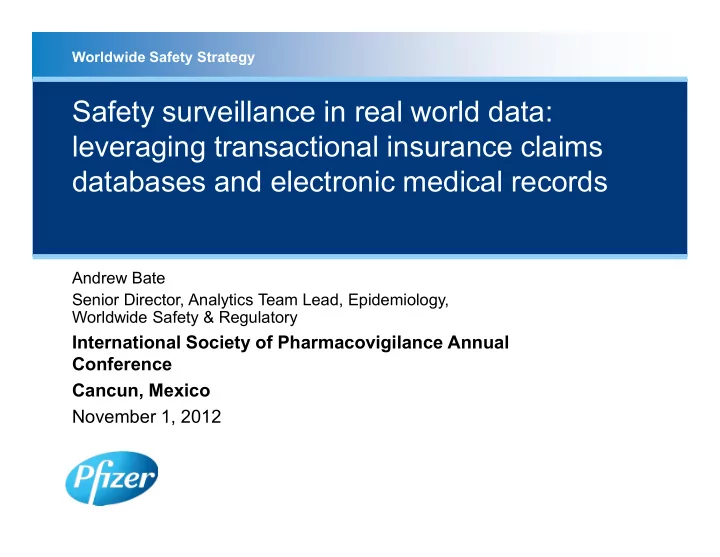

Worldwide Safety Strategy Safety surveillance in real world data: leveraging transactional insurance claims databases and electronic medical records Andrew Bate Andrew Bate Senior Director, Analytics Team Lead, Epidemiology, Worldwide Safety & Regulatory International Society of Pharmacovigilance Annual Conference Cancun, Mexico November 1, 2012
Worldwide Safety Strategy Overview • Real world data for analysis – Examples of databases • Recent and ongoing global initiatives on safety surveillance research safety surveillance research • Differing data access models for surveillance – Centralized v distributed/federated
Worldwide Safety Strategy Some selected observational databases Database Country Characteristic Population Size THIN GP primary care UK 10.5 M 1 database Danish National Health Denmark Healthcare 5.5 M 2 Service Register Database registry of care Premier Clinical data from 130 M+ patient US the hospitals discharges 3 Normative Health Normative Health Transactional Transactional Information (NHI) claims records of US 60 M+ 4 Database a commercial health insurer Health Insurance Review Insurance Claims and Assessment Service from near Korea 48 M 5 (HIRA) universal national system 1 Blak et al Generalisability of The Health Improvement Network (THIN) database: demographics, chronic disease prevalence and mortality rates. Informatics in Primary Care 2011;19:251–5 2 Furu K. et. al. The Nordic Countries as a Cohort for Pharmacoepidemiological Research. Basic & Clinical Pharmacology &Toxicology 2009; 106: 86-94 3 Fisher BT et al. In-hospital databases In Pharmacoepidemiology 5 th Edn 2011 pp 244-258 4 Seeger J, Daniel GW. Commercial Insurance Databases. In Pharmacoepidemiology 5 th Edn 2011 pp 189-208 5 Kimura T et al. Pharmacovigilnace systems and databases in Korea, Japan and Taiwan. Pharmacoepidemiology and Drug Safety. 2011; 20: 1237–1245
Worldwide Safety Strategy International and National Initiatives addressing database surveillance • FDA Sentinel Initiative • Observational Medicines Outcomes Partnership (OMOP) • Innovative Medicines Initiative (IMI) project: PROTECT – European Community's Seventh Framework Programme European Community s Seventh Framework Programme (FP7/2007-2013) for the Innovative Medicine Initiative • European Commission Seventh Framework Programme (FP-7) of the Research Directorate: EU_ADR • CIOMS VIII “Practical Aspects of Signal Detection in Pharmacovigilance” • Many other international, national and regional initiatives
Worldwide Safety Strategy Sentinel Initiative • Use large claims databases and EHRs for analysis of drug outcomes • Link in “distributed network” • FDAAA call for access to: 25M patient • FDAAA call for access to: 25M patient records by 2010 – 100M patient records by 2012 Source: Janet Woodcock ”CDER Priorities for 2009” Accessed FDA website 14/1/2009
Worldwide Safety Strategy Novel Use of Claims & EMRs for signal detection/refinement How to best utilise the wealth of Real World Data and does its value change depending on purpose? Signal Generation Signal Signal Product • Any Medical Event Approval & Refinement Evaluation • Designated Medical Events Launch Rapid Time Consuming Detect the unexpected Test the anticipated Less persuasive Convincing 6
Worldwide Safety Strategy OMOP • The Observational Medical Outcomes Partnership (OMOP) is a public-private partnership designed to help improve the monitoring of drugs for safety. The partnership will conduct a two-year initiative to research methods that are feasible and useful to analyze existing healthcare databases to identify and evaluate safety and benefit issues of drugs already on the market.
Worldwide Safety Strategy OMOP Data Community OMOP Extended Consortium OMOP Research Core Humana HSRC Partners Regenstrief HealthCare Research Lab Centralized data Thomson Reuters GE SDI Health VA Distributed Network http://omop.fnih.org
Worldwide Safety Strategy Common data model role in OMOP Analysis process Source 1 Source 2 Source 3 Transformation to OMOP common data model OMOP Analysis Analysis method results http://omop.fnih.org
Worldwide Safety Strategy Database model heat map Database model is that of OMOP of OMOP CDM Shows how well different variables convert into a Common Data Model
Worldwide Safety Strategy Performance characteristics of methods on THIN in OMOP CDM Measure Threshold Sensitivity Specificity PRR PRR 95% LBCI >1 0.67 0.68 USCCS USCCS OR >1 and LBCI >1 OR >1 and LBCI >1 0 78 0.78 0 59 0.59 (a=0.05) HDPS RR >1 and LBCI >1 0.50 0.76 (a=0.05) Comparison against the OMOP reference set of established drug-event combinations 1 1 Stang et al (2010). "Advancing the science for active surveillance: rationale and design for the Observational Medical Outcomes Partnership." Annals of Internal Medicine 153(9): 600-606.
Worldwide Safety Strategy Challenging Issues • Optimal data set(s)s, or combinations thereof for surveillance for specific medicinal products? • Implications of different Data access approaches • Under what circumstances do algorithmic methods perform best and with what level of effectiveness? • What performance characteristics and what processes • What performance characteristics and what processes are needed to effectively use novel surveillance strategies?
Worldwide Safety Strategy Conclusions • Multiple rich heterogeneous and intricately constructed ‘real world’ data sets of Electronic Medical Records and Transactional Claims databases – Surveillance approaches are now being innovatively applied to such data – Several initiatives and partnerships doing essential S l i iti ti d t hi d i ti l foundational work in the field – Challenging how to determine how to best utilise this wealth of data, and how to best incorporate such analyses into overall safety strategies • Analysis of real world data is only one potential component of an overall continual assessment of risk benefit
Recommend
More recommend